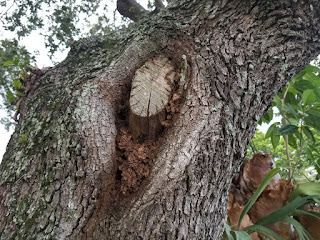Termites are silent destroyers, and discovering termite holes in a tree can be unsettling for any NYC property owner. While subterranean termites are the most common culprits in urban areas, they can destroy a tree if left unchecked. Let’s discuss how to spot termite activity, protect trees, and tackle an infestation.
Common Trees in the NYC Metro Area That Suffer Most From Termites
| Tree Type | Termite Susceptibility | Additional Notes |
|---|---|---|
| Oak (Various species) | Moderate | Older, stressed oaks are more vulnerable. |
| Maple (Various species) | Moderate | Damaged or decaying trees are especially at risk. |
| Willow | High | Prone to harboring termite colonies, especially if near water sources. |
| Birch | High | Thin bark makes them a preferred target for termites. |
| Ash | Moderate to High | Susceptibility increases if pests like the Emerald Ash Borer weaken the tree. |
Warning Signs: Termite Holes and Beyond
- Small Holes: Termites often create pencil-sized entry and exit holes in the bark or at the base of a tree.
- Mud Tubes: Subterranean termites build these protective tunnels along the tree’s trunk or branches to travel between the nest and the food source (your tree!).
- Frass: These wood-colored droppings can be found near holes or at the tree’s base.
- Swarmers: This winged stage of the termite colony emerges in spring. Seeing them around your trees signals an active infestation nearby.

credit: marksurbanforest.blogspot.com
The Dangers of Termites in Trees
- Structural Damage: Termites feast on cellulose, weakening the tree from within. This can make it more susceptible to storm damage or complete collapse.
- Spread to Structures: An untreated infestation in a tree poses a risk to your home and other wooden structures on your property.
- Compromised Tree Health: Even if structural collapse isn’t a concern, termite damage can sap a tree’s vigor, leading to decline and susceptibility to other pests and diseases.
What to Do
- Don’t Panic! Termite holes don’t mean your tree is doomed. The severity of the damage determines the best course of action.
- Call a Tree Service. A professional tree service can assess the extent of the infestation, identify the termite species, and map out a treatment plan. Never try to disturb the termite activity yourself—this will make the situation harder for the experts to assess.
- Treatment options:
- Soil Treatments: Liquid termiticides are applied to the soil around the tree’s base, creating a barrier that prevents termites from reaching the tree. They also target the underground nest.
- Tree Injections: Specialized insecticides can sometimes be injected directly into infested trees, offering targeted control.
- Baiting Systems: These involve strategically placing termite bait stations around the tree. Termites feed on the bait and return it to the colony, gradually eliminating the population.
Prevention is Key
- Reduce Moisture: Termites thrive in damp environments. Address any drainage problems near trees and avoid overwatering. Repair any leaks that might cause elevated moisture around the tree’s base.
- Eliminate Wood-to-Ground Contact: Remove any wooden debris, old mulch, or stacked firewood from direct contact with your trees.
- Regular Inspections: Check trees regularly for the signs of termite activity described above, especially during the swarming season.
NYC Tree Trimming & Removal Corp: Protecting Your Trees from the Inside Out
Termites aren’t just a threat to your home; they can seriously damage your precious trees. Our certified arborists offer comprehensive termite inspections, accurate identification, and personalized treatment plans to safeguard your valuable trees. When necessary, we work with experienced pest control professionals to provide a coordinated solution that protects your entire property.
